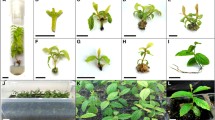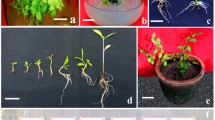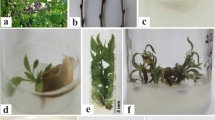Abstract
The superior quality of Stephania dentifolia is determined by the presence of desirable multiple alkaloids and the case with which one can multiply the healthy and superior source plants in vitro is an important requisite. Other factors related to successful propagation strategies are the cost of micropropagation, biomass production, and its medicinal content. In the present study, micropropagation was carried out from nodal explants collected from three parts of healthy S. dentifolia vines comprising the lower, middle and upper parts. The upper material was the most tender and the micropropagation effect was the best. The other two parts could also be used in micropropagation because of their lower pollution rate and higher induction rate. The tender stem section soaked in 70% alcohol for 15 s and then in 2.5% NaClO solution for 10 min, of which the pollution rate was 10.6%. The explants cultured on MS medium supplemented with 1.0 mg L−1benzyl adenine (BA), 0.2 mg L−1 naphthalene acetic acid (NAA), 0.5 mg L−1kinetin 0.1 mg L−1 thidiazuron and 2 g L−1 powdered activated carbon (PAC) resulted in the formation of maximum induction rate (88.32%), and microshoots were elongated (4 cm) within 3 weeks of culture period. Enhanced axillary bud proliferation and production of mass number of micro shoots was achieved by the continuous subculture in MS medium containing 0.1 mg L−1 NAA and 2 g L−1 PAC. In vitro regenerated shoots were rooted on 1/2 MS with 0.5 mg L−1 indole-3-butyric acid (IBA). After successful acclimatization, rooted plants were transferred to poly-ethylene pots containing a soil: perlite (3:1 v/v) mixture with 100% of survival rate. We improved the efficiency and reduced the costs of micropropagation of S. dentifolia via artificial cultivation.
Key message
In vitro regenerated shoots were rooted on 1/2 MS with 0.5 mg L-1 indole-3-butyric acid (IBA).

Similar content being viewed by others
References
Anand SP, Jayakumar E, Jeyachandran R, Nandagobalan V, Doss A (2012) Direct organogenesis of Passiflora foetida L. through nodal explants. Plant Tissue Cult Biotechnol 22(1):87–91. https://doi.org/10.3329/ptcb.v22i1.11266
Arikat NA, Jawad FM, Karam NS, Shibli RA (2004) Micropropagation and accumulation of essential oils in wild sage (Salvia fruticosa Mill.). Scientia Horticulturae 100(1–4):193–202. https://doi.org/10.1016/j.scienta.2003.07.006
Cavallari N, Artner C, Benkova E (2021) Auxin-regulated lateral root organogenesis. Cold Spring Harb Perspect Biol 13(7):a039941. https://doi.org/10.1101/cshperspect.a039941
Hijikata A, Shionyu-Mitsuyama C, Nakae S, Shionyu M, Ora M, Kanaya S, Hirokawa T, Nakajima S, Watashi K, Shirai T (2022) Evaluating cepharanthine analogues as natural drugs against SARS-CoV-2. FEBS Open Bio 122(1):285–294. https://doi.org/10.1002/2211-5463.13337
Hu R, Dai X, Lu Y, Pan Y (2010) Preparative separation of isoquinoline alkaloids from Stephania yunnanensis by pH-zone-refining counter-current chromatography. J Chromatogr B 878(21):1881–1884. https://doi.org/10.1016/j.jchromb.2010.05.005
Huang N, Tang F, Fu C, Li F, Zhao Z (2007) Tissue culture and rapid proliferation of Stephania kwangsiensis. Chin Tradit Herb Drugs 38(3):445–449 (in Chinese)
Hui S, Dary C, Jacques F, Ollivier E, Bun S, Cheng SK, Sothea K, Peou Y, Jabbour F (2017) The world checklist of Stephania (Menispermaceae), with notes on types. Phytotaxa 292(2):101–118. https://doi.org/10.11646/phytotaxa.298.2.1
Kupchan SM, Liepa AJ, Fujita T (1973) New phenolic Hasubanan alkaloids from Stephania abyssinica. J Org Chem 38(1):151–153. https://doi.org/10.1021/jo00941a033
Liu H, Liao WQ, Lin RX, Fan L, Sun J, Chen HY, Liu F, Yang AP (2021) Hasubanan alkaloids with anti-inflammatory activity from Stephania longa. Nat Prod Res 2:1–6. https://doi.org/10.1080/14786419.2021.1928118
Ma YS, Yu H, Li YY, Yan H, Cheng X (2008) A study of genetic structure of Stephania yunnanensis (Menispermaceae) by DALP. Biochem Genet 46(s3–4):227. https://doi.org/10.1007/s10528-008-9146-x
Mei YE, Wang BC (2004) Advances of explant browning in plant tissue culture. Lett Biotechnol 15(4):426–428
Murashige T, Skoog F (1962) A revised medium for rapid growth and bioassays with tobacco tissue culture. Physiol Plant 15:473–497. https://doi.org/10.1111/j.1399-3054.1962.tb08052.x
Semwal DK, Badoni R, Semwal R, Kothiyal SK, Singh G, Rawat U (2010) The genus Stephania (Menispermaceae): chemical and pharmacological perspectives. J Ethnopharmacol 132(2):369–383
Shekhawat MS, Kannan N, Manokari M, Ravindran C (2015) In vitro regeneration of shoots and ex vitro rooting of an important medicinal plant Passiflora foetida L. through nodal segment cultures. J Genet Eng Biotechnol 13(2):209–214. https://doi.org/10.1016/j.jgeb.2015.08.002
Shi S, Li C, Liu Z, Lin C, Du J, Su W, Mao Z (2021) Seed dormancy and its breaking method for Stephania epigaea. J West China Forestry Sci 50(6):117–123
Shiji PC, Siril EA (2018) An improved micropropagation and ex vitro rooting of a commercially important crop Henna (Lawsonia inermis L.). Physiol Mol Biol Plants 24:1273–1284
Wang GQ (2014) National compendium of Chinese herbal medicine. People’s Medical Publishing House, Beijing, pp 411–412
Wang M, Zhang XM, Fu X, Zhang P, Hu WJ, Yang BY, Kuang HX (2022) Alkaloids in genus Stephania (Menispermaceae): a comprehensive review of its ethnopharmacology, phytochemistry, pharmacology and toxicology. J Ethnopharmacol 293:115248. https://doi.org/10.1016/j.jep.2022.115248
Xin A, Zhang Y, Zhang Y, Di D, Liu J (2018) Development of an HPLC-DAD method for the determination of five alkaloids in Stephania yunnanensis Lo and in rat plasma after oral dose of Stephania dentifolia Lo extracts. Biomed Chromatogr 32(10):e4292. https://doi.org/10.1002/bmc.4292
Xu M, Zhang X, Yu J, Guo Z, Li Y, Wu J, Chi Y (2021) First report of Fusarium ipomoeae causing peanut leaf spot in China. Plant Dis 105(11):3754. https://doi.org/10.1094/PDIS-01-21-0226-PDN
Yan Q, Li RX, Xin AY, Liu JX, Li WG, Di DL (2017) Research on anticancer activity of isocorydine and its derivatives. Zhongguo Zhong Yao Za Zhi 42(16):3152–3158. https://doi.org/10.19540/j.cnki.cjcmm.20170512.008. (in Chinese)
Yang LJ, Yang ZD, Li ZJ, Yang SH, Shu ZM (2021) Stephtetrandrine A-D, bisbenzylisoquinoline alkaloids from Stephania tetrandra. Nat Prod Res. https://doi.org/10.1080/14786419.2021.1961135
Zhang LB, Rao GX (2009) Aporphine, protoberberine and morphine alkaloids from the tubers of Stephania yunnanensis. Biochem Syst Ecol 37(5):622–625. https://doi.org/10.1016/j.bse.2009.08.005
Zhao W, Liu M, Shen C, Liu H, Zhang Z, Dai W, Liu X, Liu J (2019) Differentiation, chemical profiles and quality evaluation of five medicinal Stephania species (Menispermaceae) through integrated DNA barcoding, HPLC-QTOF-MS/MS and UHPLC-DAD. Fitoterapia 141:104453
Zhao W, Shen C, Zhu J, Ou C, Liu M, Dai W, Liu X, Liu J (2020) Identification and characterization of methyltransferases involved in benzylisoquinoline alkaloids biosynthesis from Stephania intermedia. Biotechnol Lett 42(3):461–469. https://doi.org/10.1007/s10529-019-02785-0
Zhao Y, Cui L, Yang XX, Sun X, Liu Y, Yang Z, Zhu L, Peng C, Li D, Cai J, Ma Y (2021) Sinoacutine inhibits inflammatory responses to attenuates acute lung injury by regulating NF-κB and JNK signaling pathways. BMC Complement Med Ther 1:284. https://doi.org/10.1186/s12906-021-03458-0
Zuo AX, Li L, Ma YS, Rao GX (2013) Akaloids from roots of Stephania dentifolia. Zhongguo Zhong Yao Za Zhi 38(4):574–577 (in Chinese)
Acknowledgements
This work was jointly supported by National Natural Science Foundation of China (NO. 32160415); Biological Quality Engineering Project (NO. 503190106); Yunnan Provincial Joint Special Project for Basic Research in Agriculture (202101BD070001-114); Yunnan Province Xingdian Talents Support Plan and Yunnan Provincial Department of Education Fund for Scientific Research (No. 2020J0413).
Funding
Natural Science Foundation of China (Grant no. 32160415), Biological Quality Engineering Project (Grant no. 503190106), Yunnan Provincial Joint Special Project for Basic Research in Agriculture (Grant no. 202101BD070001-114), Yunnan Province Xingdian Talents Support Plan, Scientific Research Foundation for Returned Scholars of Ministry of Education (Grant no. 2020J0413).
Author information
Authors and Affiliations
Corresponding author
Ethics declarations
Conflict of interest
The authors declare no conflicts of interest.
Additional information
Communicated by Patricia Marconi.
Publisher's Note
Springer Nature remains neutral with regard to jurisdictional claims in published maps and institutional affiliations.
Rights and permissions
Springer Nature or its licensor (e.g. a society or other partner) holds exclusive rights to this article under a publishing agreement with the author(s) or other rightsholder(s); author self-archiving of the accepted manuscript version of this article is solely governed by the terms of such publishing agreement and applicable law.
About this article
Cite this article
Yu, L., Duan, Y. & Zhan, H. An improved micropropagation of a medicinal plant Stephania dentifolia. Plant Cell Tiss Organ Cult 153, 219–224 (2023). https://doi.org/10.1007/s11240-022-02443-w
Received:
Accepted:
Published:
Issue Date:
DOI: https://doi.org/10.1007/s11240-022-02443-w




